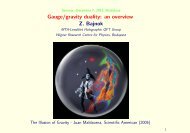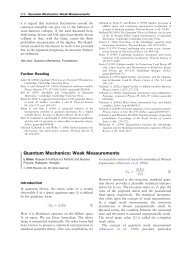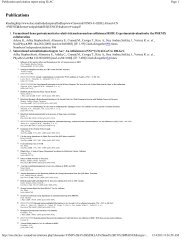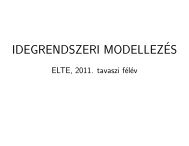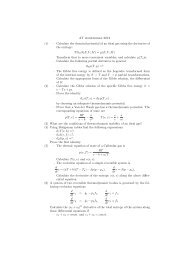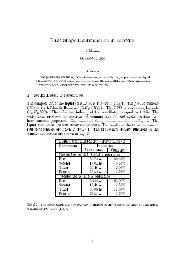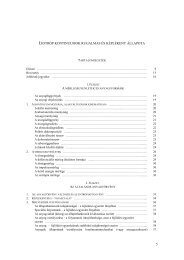Second Law of thermodynamics and the failure of rock materials
Second Law of thermodynamics and the failure of rock materials
Second Law of thermodynamics and the failure of rock materials
Create successful ePaper yourself
Turn your PDF publications into a flip-book with our unique Google optimized e-Paper software.
<strong>Second</strong> <strong>Law</strong> <strong>of</strong> <strong><strong>the</strong>rmodynamics</strong> <strong>and</strong> <strong>the</strong> <strong>failure</strong> <strong>of</strong> <strong>rock</strong> <strong>materials</strong><br />
P. Ván<br />
Budapest University <strong>of</strong> Technology <strong>and</strong> Economics, Department <strong>of</strong> Chemical Physics<br />
B. Vásárhelyi<br />
Budapest University <strong>of</strong> Technology <strong>and</strong> Economics, Department <strong>of</strong> Engineering Geology<br />
ABSTRACT:<br />
The relation <strong>of</strong> nonequilibrium <strong><strong>the</strong>rmodynamics</strong> to some <strong>failure</strong> <strong>and</strong> fracture <strong>the</strong>ories <strong>of</strong> <strong>rock</strong> mechanics is<br />
investigated. The basic concepts are given to connect <strong>failure</strong> to <strong>the</strong> properties <strong>of</strong> material equations describing<br />
<strong>the</strong> elastic properties. The resulted in <strong>the</strong>rmodynamic conditions are proved to be compatible with classical<br />
localization <strong>and</strong> <strong>failure</strong> <strong>the</strong>ories <strong>of</strong> solid <strong>materials</strong>. Compatibility with experiments <strong>and</strong> some empirical, adhoc<br />
<strong>failure</strong> criteria <strong>of</strong> <strong>rock</strong>s is also demonstrated.<br />
1 INTRODUCTION<br />
In continuum physical <strong>the</strong>ories <strong>the</strong> complex<br />
mechanical properties <strong>of</strong> material are described by<br />
constitutive functions. One <strong>of</strong> <strong>the</strong> basic construction<br />
methods to get reasonable constitutive functions is<br />
based on <strong>the</strong> <strong>Second</strong> <strong>Law</strong> <strong>of</strong> <strong><strong>the</strong>rmodynamics</strong>. The<br />
material equations have to be compatible with <strong>the</strong><br />
<strong>Second</strong> <strong>Law</strong> in every system where dissipation<br />
occurs, including fracture <strong>and</strong> <strong>failure</strong> <strong>of</strong> <strong>rock</strong><br />
<strong>materials</strong>, too. Here (<strong>of</strong> course) <strong><strong>the</strong>rmodynamics</strong> is<br />
understood not only as a <strong>the</strong>ory to deal with <strong>the</strong>rmal<br />
phenomena <strong>and</strong> temperature changes, but as <strong>the</strong><br />
<strong>the</strong>ory dealing with <strong>the</strong> stability <strong>of</strong> <strong>materials</strong>. In this<br />
respect <strong>Second</strong> <strong>Law</strong> is understood as a requirement<br />
<strong>of</strong> stability, restricting <strong>the</strong> possible material<br />
equations <strong>of</strong> all media.<br />
In <strong>rock</strong> mechanics <strong>the</strong> pure mechanical properties<br />
are modeled by continuum mechanical methods, <strong>and</strong><br />
even <strong>the</strong> violations <strong>of</strong> material stability are<br />
understood in most cases as pure mechanical<br />
phenomena using fracture mechanics as modeling<br />
tool. Fracture mechanics deals with holes (cracks)<br />
<strong>and</strong> discontinuities embedded in an ideal mechanical<br />
continuum. Several works use statistical methods to<br />
underst<strong>and</strong> <strong>the</strong> interaction <strong>and</strong> interlocking <strong>of</strong> cracks<br />
in <strong>the</strong> mechanical continuum. In <strong>rock</strong>s damage<br />
processes include not only microcracking <strong>and</strong><br />
interlocking <strong>of</strong> cracks but several o<strong>the</strong>r different<br />
mechanisms, <strong>the</strong>refore <strong>the</strong> applicability <strong>of</strong> this kind<br />
<strong>of</strong> statistical considerations is questionable. To<br />
underst<strong>and</strong> <strong>the</strong> appearing broad range <strong>of</strong> different<br />
phenomena requires to apply different<br />
phenomenological methods <strong>and</strong> to underst<strong>and</strong>, in<br />
what sense could be <strong>the</strong> different approaches<br />
unified. Some new developments in modern<br />
nonequilibrium <strong><strong>the</strong>rmodynamics</strong> give a hope to<br />
deepen our underst<strong>and</strong>ing <strong>of</strong> <strong>the</strong> role <strong>of</strong> <strong>the</strong> <strong>Second</strong><br />
<strong>Law</strong> in mechanical modeling <strong>and</strong> to extend <strong>the</strong><br />
existing models to give simple descriptions <strong>of</strong><br />
several related phenomena.<br />
Failure <strong>and</strong> change <strong>of</strong> elastic properties are<br />
treated as independent phenomena in mechanics.<br />
The situation is similar in <strong>the</strong> <strong>the</strong>ories <strong>of</strong> plasticity,<br />
where <strong>the</strong> yield criteria is considered to be<br />
independent on elastic properties <strong>of</strong> <strong>the</strong> material (but<br />
not independent on <strong>the</strong> <strong>Second</strong> <strong>Law</strong>). Continuum<br />
damage mechanics (see e.g. Krajcinovic 1996) is a<br />
<strong>the</strong>ory motivated by <strong>the</strong> need <strong>of</strong> unification <strong>of</strong><br />
<strong>failure</strong> <strong>and</strong> nonlinear elasticity. The original idea is<br />
that growing damage can lead to <strong>failure</strong>. However,<br />
after some initial attempt <strong>the</strong> researchers in damage<br />
mechanics gave up to find a <strong>the</strong>oretical connection<br />
<strong>and</strong> nowadays <strong>the</strong> damage surfaces (critical<br />
damage) are given independently on <strong>the</strong> change <strong>of</strong><br />
mechanic properties.<br />
In this short paper we will show that a connection<br />
can be found, if <strong>the</strong> foundations <strong>of</strong> <strong>the</strong> underlying<br />
nonequilibrium <strong>the</strong>rmodynamic <strong>the</strong>ories are<br />
investigated. Failure <strong>and</strong> fracture can be considered<br />
as a kind <strong>of</strong> material instability. Moreover, we can<br />
use similar concepts <strong>and</strong> methods to <strong>the</strong> case <strong>of</strong><br />
phase transitions in fluid <strong>and</strong> gaseous bodies. As<br />
particular applications we will show how <strong>the</strong><br />
classical Griffith concept (<strong>and</strong> all <strong>the</strong> so called<br />
energy methods) includes <strong>the</strong>rmodynamic instability
<strong>and</strong> show, how o<strong>the</strong>r specific <strong>rock</strong> mechanical<br />
<strong>failure</strong> criteria can be understood as violation <strong>of</strong><br />
<strong>the</strong>rmodynamic stability. At <strong>the</strong> end a<br />
<strong>the</strong>rmodynamic improvement <strong>of</strong> <strong>the</strong> empirical<br />
criteria <strong>of</strong> Lade is given using <strong>the</strong> ideas above <strong>and</strong> a<br />
simple particular model.<br />
2 DYNAMIC AND THERMODYNAMIC<br />
STABILITY<br />
In nonequilibrium <strong><strong>the</strong>rmodynamics</strong> <strong>the</strong> <strong>Second</strong> <strong>Law</strong><br />
introduces <strong>the</strong> entropy function as <strong>the</strong> manifestation<br />
<strong>and</strong> <strong>the</strong>oretical tool to deal with <strong>the</strong> stability <strong>of</strong><br />
equilibrium. There are two different aspects to be<br />
considered here:<br />
Thermodynamic stability; <strong>the</strong> convexity <strong>of</strong><br />
entropy function. This is a static stability<br />
requirement that ensures <strong>the</strong> stability <strong>of</strong> equilibrium<br />
states <strong>of</strong> matter in case <strong>of</strong> small external<br />
perturbations <strong>of</strong> <strong>the</strong> <strong>the</strong>rmodynamic state,<br />
independently <strong>of</strong> <strong>the</strong> particular dynamic equations.<br />
Phase boundaries appear where <strong>the</strong>rmodynamic<br />
stability is violated.<br />
Dynamic stability <strong>of</strong> <strong>the</strong>rmodynamic equilibrium;<br />
positive entropy production, where particular<br />
dynamic equations <strong>of</strong> matter are considered. The<br />
connection between <strong>the</strong> two stability concepts is<br />
clear in case <strong>of</strong> <strong>the</strong> so called ‘equilibrium’ systems,<br />
where <strong>the</strong> state variables <strong>and</strong> <strong>the</strong> relations between<br />
<strong>the</strong>m are those that can be measured in equilibrium.<br />
Thermodynamic <strong>and</strong> dynamic stability toge<strong>the</strong>r<br />
restrict <strong>the</strong> possible functional form <strong>of</strong> <strong>the</strong><br />
constitutive functions to give <strong>the</strong> asymptotic stability<br />
<strong>of</strong> specific equilibrium states (Glansdorff <strong>and</strong><br />
Prigogine 1971, Gurtin 1975). For homogeneous<br />
(discrete) systems this idea was developed in detail<br />
giving a remarkable conceptual background <strong>of</strong> <strong>the</strong><br />
<strong>Second</strong> <strong>Law</strong> (Matolcsi 1992, 1996a, b).<br />
The situation is more involved in nonequilibrium<br />
systems where <strong>the</strong> hypo<strong>the</strong>ses <strong>of</strong> local equilibrium is<br />
violated, <strong>the</strong> ‘equilibrium’ state variables are<br />
inadequate to characterize <strong>the</strong> processes (Ván 1995).<br />
For systems with internal variables (an important<br />
class <strong>of</strong> nonequilibrium systems) <strong>the</strong> first<br />
requirement, <strong>the</strong> <strong>the</strong>rmodynamic stability results in<br />
<strong>the</strong> desired <strong>the</strong>oretical tool to describe material<br />
instability <strong>of</strong> mechanical origin. Let us consider a<br />
simple mechanical system, where <strong>the</strong> traditional<br />
extensive state variables <strong>the</strong> specific entropy s <strong>and</strong><br />
deformation ε are supplemented by a set <strong>of</strong> internal<br />
variables =(α i , i=1,…,n). Each internal variable<br />
can be a tensor <strong>of</strong> any order. Different variable sets<br />
<strong>and</strong> <strong>the</strong>rmodynamic potential functions are used in<br />
<strong>the</strong>se kind <strong>of</strong> investigations. In mechanics<br />
traditionally we can meet <strong>the</strong> Helmholtz free energy<br />
φ(T, , ) <strong>and</strong> <strong>the</strong> Gibbs free energy ψ(T, , ), too.<br />
The corresponding variables are <strong>the</strong> temperature T,<br />
deformation <strong>and</strong> stress <strong>and</strong> respectively. The<br />
two free energies <strong>and</strong> <strong>the</strong> internal energy e(s, , )<br />
are related by partial Legendre transformations:<br />
e = φ + Ts = ψ + Ts + : ,<br />
where s is <strong>the</strong> entropy.<br />
The <strong>the</strong>rmodynamic stability appears as <strong>the</strong><br />
requirement <strong>of</strong> concavity <strong>of</strong> <strong>the</strong> entropy function. A<br />
concave entropy results in conditions for <strong>the</strong> o<strong>the</strong>r<br />
<strong>the</strong>rmodynamic potentials, too. In case <strong>of</strong> pure<br />
mechanical processes, when temperature is constant,<br />
concave entropy gives a convex Helmholtz free<br />
energy. The requirement <strong>of</strong> a convexity in <strong>the</strong><br />
relevant variables for a two times differentiable<br />
Helmholtz free energy can be written as<br />
2<br />
( d , d ) ⋅ D φ ⋅ ( d , d ) =<br />
2 2<br />
⎛ ∂ φ ∂ φ ⎞<br />
⎜<br />
⎟<br />
2<br />
= ( d , d ) ⋅⎜<br />
∂ ∂ ∂ ⎟<br />
2 2<br />
⋅ ( d , d<br />
⎜ ∂ φ ∂ φ ⎟<br />
⎜<br />
2 ⎟<br />
⎝ ∂ ∂ ∂ ⎠<br />
) > 0<br />
(1)<br />
for every (d , d ). Here a notation from <strong>the</strong><br />
mechanical literature is applied where d <strong>and</strong> d<br />
are arbitrary vectors from <strong>the</strong> linear spaces where<br />
<strong>the</strong> deformation <strong>and</strong> internal variables are defined<br />
respectively. D 2 φ denotes <strong>the</strong> second derivative φ.<br />
To investigate <strong>the</strong> inequality (1) Sylvester condition<br />
for symmetric matrices can be applied. It is<br />
supposed that <strong>the</strong> functional form <strong>of</strong> <strong>the</strong> entropy<br />
(<strong>and</strong> <strong>the</strong> free energies consequently) does not<br />
contain differential or integral operators. However,<br />
<strong>the</strong> process dependence <strong>of</strong> <strong>the</strong> corresponding<br />
equations is considered through <strong>the</strong> introduced<br />
internal variables. Therefore <strong>the</strong> resulted stressstrain<br />
relations will be rate dependent, but a rate<br />
form notation is not necessary <strong>and</strong> could even be<br />
misleading.<br />
A (partially) convex Helmholtz free energy gives<br />
requirements for <strong>the</strong> Gibbs free energy, but <strong>the</strong>se<br />
requirements cannot be expressed as a simple<br />
concavity or convexity for all variables (one can say<br />
that Gibbs free energy is convex in <strong>the</strong> internal<br />
variables <strong>and</strong> concave in <strong>the</strong> o<strong>the</strong>r ones), <strong>the</strong>refore<br />
sometimes a conversion to Helmholtz free energy<br />
can be useful for <strong>the</strong>rmodynamic stability<br />
calculations.<br />
The subset <strong>of</strong> <strong>the</strong> state space where <strong>the</strong> conditions<br />
<strong>of</strong> <strong>the</strong>rmodynamic stability are satisfied determines<br />
<strong>the</strong> static stability domain <strong>of</strong> <strong>the</strong> material. Outside<br />
this domain <strong>the</strong> material is unstable, without fur<strong>the</strong>r<br />
constraint fails. From a physical point <strong>of</strong> view <strong>the</strong><br />
situation is analogous to phase boundaries in case <strong>of</strong><br />
fluid bodies but in solid bodies <strong>the</strong> observed<br />
phenomena can be qualitatively different. Here<br />
<strong>failure</strong> changes <strong>the</strong> properties <strong>of</strong> <strong>the</strong> material <strong>and</strong> <strong>the</strong><br />
internal interactions (for example <strong>the</strong> cohesion<br />
vanishes <strong>and</strong> dry friction will be <strong>the</strong> dominating<br />
dissipation mechanism). Moreover, in this case all <strong>of</strong>
our previous implicit assumptions on <strong>the</strong><br />
homogeneous representative volume elements can<br />
become meaningless. In solid <strong>materials</strong> we cannot<br />
speak unambiguously <strong>of</strong> an o<strong>the</strong>r homogeneous<br />
phase after <strong>the</strong> loss <strong>of</strong> <strong>the</strong>rmodynamic stability, in a<br />
continuum description <strong>the</strong> phases are immediately<br />
localized. This is best seen if we give a closer look<br />
at <strong>the</strong> condition <strong>of</strong> stability loss <strong>and</strong> recognize that<br />
(1) can be interpreted as a generalization <strong>of</strong> <strong>the</strong><br />
classical Hadamard-Hill localization condition <strong>of</strong><br />
shear b<strong>and</strong>ing. Using purely mechanical arguments<br />
<strong>and</strong> investigating jump surfaces in <strong>the</strong> velocity field<br />
shear b<strong>and</strong>ing appears in <strong>the</strong> direction n if<br />
det( n ⋅ C ⋅n)<br />
= 0 , (2)<br />
where C is <strong>the</strong> fourth order stiffness tensor, that can<br />
be given as <strong>the</strong> second partial derivative <strong>of</strong> <strong>the</strong><br />
Helmholtz free energy<br />
2<br />
∂ φ<br />
C : =<br />
∂<br />
2 .<br />
(Hadamard 1903, Hill 1962, Asaro & Rice 1977)<br />
We can see that C is <strong>the</strong> (1,1) submatrix in our<br />
general <strong>the</strong>rmodynamic stability condition (1). A<br />
necessary condition <strong>of</strong> this submatrix to be positive<br />
definite is closely related to <strong>the</strong> mentioned classical<br />
localization condition <strong>of</strong> Hadamard <strong>and</strong> Hill, <strong>the</strong><br />
later gives <strong>the</strong> boundary <strong>of</strong> <strong>the</strong> stability domain<br />
when equality holds. A more general requirement <strong>of</strong><br />
positive definite elastic moduli can be derived from<br />
energetic-stability considerations resulting in a<br />
localization condition. This general energetic<br />
localization condition considers shear-b<strong>and</strong>ing <strong>and</strong><br />
cleavage type localization instabilities, too (see e.g.<br />
Krajcinovic 1996 <strong>and</strong> Broberg 1999). Our condition<br />
(1) can be considered as a generalization <strong>of</strong> <strong>the</strong>se<br />
classical requirements (all energetic type<br />
considerations can be interpreted as disguised<br />
<strong>the</strong>rmodynamic train <strong>of</strong> thoughts).<br />
Therefore <strong>the</strong> loss <strong>of</strong> <strong>the</strong>rmodynamic stability, at<br />
least in some cases, does not result in a<br />
homogeneous change in <strong>the</strong> material but indicates<br />
<strong>the</strong> appearance <strong>of</strong> some localized patterns, for<br />
example shear b<strong>and</strong>s. Hence <strong>the</strong> analogy with phase<br />
transitions can be misleading, instead <strong>of</strong> phase<br />
transitions we can call <strong>the</strong> related process as phase<br />
breaking. Of course more developed localization<br />
models considering <strong>the</strong> thickness <strong>of</strong> shear b<strong>and</strong>s <strong>and</strong><br />
o<strong>the</strong>r gradient dependent nonlocal effects can also be<br />
introduced.<br />
Internal variables give <strong>the</strong> basic <strong>the</strong>oretical<br />
concept to <strong>the</strong>rmodynamic motivated approaches <strong>of</strong><br />
plasticity, damage mechanics or rheology. In this<br />
case <strong>the</strong> fundamental Helmholtz relation expressed<br />
by <strong>the</strong> Gibbs free energy ψ(T, , ) for a<br />
homogeneous representative volume element can be<br />
written as<br />
dψ = −sdT<br />
− : d − A ⋅ d , (3)<br />
where T is <strong>the</strong> temperature, <strong>and</strong> are <strong>the</strong> stress<br />
<strong>and</strong> <strong>the</strong> deformation respectively, <strong>the</strong> double dot<br />
denotes <strong>the</strong> trace <strong>of</strong> <strong>the</strong> product <strong>of</strong> <strong>the</strong> two tensors<br />
<strong>and</strong> A is <strong>the</strong> affinity conjugated to <strong>the</strong> internal<br />
variables This relation is a short <strong>and</strong> physically<br />
interpretable version <strong>of</strong> <strong>the</strong> potential property <strong>of</strong> <strong>the</strong><br />
free energy. That property can be expressed also<br />
with partial derivatives<br />
∂ψ s = − ,<br />
∂T<br />
∂ψ<br />
∂ψ ε = − , A = − . (4)<br />
∂<br />
∂<br />
Before continuing to discuss <strong>the</strong> consequences <strong>of</strong><br />
<strong>the</strong>rmodynamic stability <strong>and</strong> o<strong>the</strong>r static phenomena,<br />
we give some hint on <strong>the</strong> dynamics emerging from<br />
<strong>the</strong>rmodynamic considerations. The o<strong>the</strong>r part <strong>of</strong> <strong>the</strong><br />
<strong>Second</strong> <strong>Law</strong> beyond <strong>the</strong> <strong>the</strong>rmodynamic stability is<br />
<strong>the</strong> requirement <strong>of</strong> positive entropy production. That<br />
postulate results in prescriptions <strong>and</strong> some very<br />
particular forms <strong>of</strong> <strong>the</strong> possible dynamic equations.<br />
For solid bodies with small deformations <strong>the</strong><br />
production <strong>of</strong> entropy multiplied by <strong>the</strong> temperature<br />
<strong>and</strong> written in terms <strong>of</strong> Gibbs free energy reads as<br />
−1<br />
2<br />
⎛ ∂ ψ ⎞ ⎛ ∂ψ<br />
⎞ ∂ψ<br />
TP =<br />
⎜<br />
: + ⋅ ≥ 0<br />
2<br />
⎟ ⎜ + ⎟ & &<br />
s<br />
. (5)<br />
⎝ ∂ ⎠ ⎝ ∂ ⎠ ∂<br />
Here <strong>the</strong> dot above <strong>the</strong> quantities denotes<br />
substantial time derivatives. It is easy to identify<br />
<strong>the</strong>rmodynamic currents <strong>and</strong> forces in <strong>the</strong> above<br />
expression <strong>and</strong> give explicit relations for <strong>the</strong><br />
dynamics <strong>of</strong> <strong>the</strong> different introduced quantities. On<br />
<strong>the</strong> o<strong>the</strong>r h<strong>and</strong> additional physical restrictions seem<br />
to be reasonable in most <strong>of</strong> <strong>the</strong> practical situations in<br />
mechanics. One <strong>of</strong> <strong>the</strong>m that <strong>the</strong> mechanical<br />
equilibration is faster than <strong>the</strong> evolution <strong>of</strong> <strong>the</strong><br />
internal variables (<strong>the</strong> terminal velocity <strong>of</strong> crack<br />
propagation in ideal elastic <strong>materials</strong> is not more<br />
than <strong>the</strong> half <strong>of</strong> <strong>the</strong> sound velocity). In this case we<br />
can suppose a mechanical equilibrium<br />
∂ψ = − . (6)<br />
∂<br />
The dynamics <strong>of</strong> <strong>the</strong> internal variables is<br />
determined as follows (as a first approximation)<br />
∂ψ<br />
& = L ( , ) ,<br />
∂<br />
where L is a material parameter, characterizing <strong>the</strong><br />
speed <strong>of</strong> <strong>the</strong> damage propagation.<br />
To investigate <strong>the</strong> <strong>the</strong>oretical <strong>and</strong> experimental<br />
relevance <strong>of</strong> this kind <strong>of</strong> dynamics is not <strong>the</strong> subject<br />
<strong>of</strong> this short paper. We remark here that typical<br />
damaging <strong>and</strong> <strong>failure</strong> mechanisms observed for<br />
brittle <strong>rock</strong>s (Bieniawski 1967 or Martin <strong>and</strong><br />
Ch<strong>and</strong>ler 1994) can be modeled by a single vectorial<br />
internal variable (supposing that microcracking is
<strong>the</strong> dominating internal mechanism) <strong>and</strong> few<br />
material parameters.<br />
A SIMPLE MODEL FOR BRITTLE FAILURE<br />
In this section a simple model <strong>of</strong> brittle material is<br />
suggested <strong>and</strong> <strong>the</strong> static stability properties are<br />
investigated. For brittle <strong>materials</strong> <strong>the</strong> microstructure<br />
is formed by microcracks, that are growing <strong>and</strong><br />
interlocking with increasing pressure. In case <strong>of</strong><br />
brittle <strong>rock</strong>s with grains <strong>the</strong> structure <strong>of</strong> microcracks<br />
is not so simple as for homogeneous <strong>materials</strong>.<br />
According to <strong>the</strong> compressive stresses <strong>the</strong>y can be<br />
intergranular <strong>and</strong> also can be formed inside <strong>the</strong><br />
grains. The mode <strong>of</strong> <strong>failure</strong> depends on <strong>the</strong> direction<br />
<strong>of</strong> <strong>the</strong> loading for slow <strong>and</strong> also for fast processes.<br />
Therefore, it seems to be reasonable to introduce a<br />
single vectorial internal variable that incorporates<br />
<strong>the</strong> average properties <strong>of</strong> microstructure. In this case<br />
we can interpret it as <strong>the</strong> average <strong>of</strong> <strong>the</strong> microcrack<br />
vectors <strong>and</strong> we will call it as damage.<br />
To deal with <strong>the</strong> static properties <strong>of</strong> particular<br />
<strong>materials</strong> a reasonable form <strong>of</strong> one <strong>of</strong> <strong>the</strong> potential<br />
functions is necessary. According to <strong>the</strong> experience<br />
<strong>and</strong> traditions a second order polynomial is<br />
suggested for <strong>the</strong> Gibbs free energy. Using <strong>the</strong><br />
symmetry requirements for isotropic <strong>materials</strong> we<br />
can get <strong>the</strong> following functional form<br />
ψ (<br />
,<br />
) =<br />
ς 2<br />
2<br />
+ ( δ + kδ<br />
) Tr<br />
2<br />
1<br />
2<br />
+ ( λ + kλ<br />
)( Tr )<br />
2<br />
γ<br />
+ ⋅ ⋅ ⋅ .<br />
2<br />
2<br />
kµ<br />
2<br />
+ ( µ + )<br />
2<br />
1<br />
+ ( β + kβTr<br />
2<br />
)<br />
:<br />
⋅<br />
+<br />
⋅<br />
+<br />
(7)<br />
Due to <strong>the</strong> isotropy only ten material constants<br />
appear <strong>and</strong> only five <strong>of</strong> <strong>the</strong>m can be considered as<br />
new. All <strong>the</strong> terms can be interpreted physically <strong>and</strong><br />
measurement methods can be suggested for <strong>the</strong><br />
material constants. There are some clues for <strong>the</strong><br />
interpretation (a more detailed treatment is given in<br />
Ván 2000).<br />
– The first term represents <strong>the</strong> energy attributed<br />
directly to <strong>the</strong> cracks.<br />
− The second term is related to <strong>the</strong> hydrostatic<br />
energy conservation <strong>of</strong> <strong>the</strong> material. δ<br />
characterizes <strong>the</strong> damage independent <strong>and</strong> kδ<br />
<strong>the</strong> damage dependent part. Pore fluid<br />
pressure can be a physical mechanism in <strong>the</strong><br />
background. (All <strong>of</strong> <strong>the</strong> parameters can<br />
depend on temperature <strong>and</strong> density <strong>of</strong> <strong>the</strong><br />
material.)<br />
− The next two terms are <strong>the</strong> usual elastic free<br />
energy contributions where µ <strong>and</strong> λ are well<br />
known elastic coefficients related to <strong>the</strong><br />
Young modulus E <strong>and</strong> Poisson ratio ν by<br />
µ=(1+ν)/E <strong>and</strong> λ=µ/E. k µ <strong>and</strong> k λ characterize<br />
<strong>the</strong>ir damage dependence.<br />
− ⋅ ⋅ is <strong>the</strong> deformation in <strong>the</strong> direction <strong>of</strong><br />
<strong>the</strong> crack surface, <strong>the</strong>refore <strong>the</strong> sixth term<br />
considers <strong>the</strong> opening <strong>of</strong> <strong>the</strong> cracks.<br />
− The last term contains <strong>the</strong> square <strong>of</strong> <strong>the</strong><br />
substantial crack vector, <strong>the</strong>refore it means an<br />
energy contribution necessary for turning <strong>the</strong><br />
cracks with <strong>the</strong> deforming media.<br />
Ano<strong>the</strong>r clue to <strong>the</strong> interpretation <strong>of</strong> <strong>the</strong> material<br />
parameters can be given by <strong>the</strong> equation <strong>of</strong> <strong>the</strong><br />
mechanical equilibrium (6) calculating <strong>the</strong> damage<br />
strain (<strong>the</strong> residual strain due to <strong>the</strong> growing<br />
damage).<br />
2<br />
0<br />
( ) : = ( 0,<br />
) = ( δ + k<br />
δ<br />
) I + β o .<br />
Here I is <strong>the</strong> second order unit tensor <strong>and</strong> <strong>the</strong><br />
circle o is <strong>the</strong> usual notation <strong>of</strong> <strong>the</strong> tensorial product<br />
in continuum mechanics.<br />
With this particular free energy we can<br />
investigate <strong>the</strong> stability thresholds suggested in <strong>the</strong><br />
condition (1). Calculating <strong>the</strong> (1,1) submatrix,<br />
related to <strong>the</strong> localization we can get that in case <strong>of</strong><br />
zero damage µ>0 <strong>and</strong> µ+ν>0.. Calculation <strong>of</strong> <strong>the</strong><br />
damage related (2,2) submatrix we can get <strong>the</strong><br />
requirement <strong>of</strong> <strong>the</strong>rmodynamic stability in case <strong>of</strong><br />
zero deformation is ζ>0. On <strong>the</strong> o<strong>the</strong>r h<strong>and</strong> several<br />
different explicit upper limits can also be calculated<br />
for <strong>the</strong> damage parameter in case <strong>of</strong> specific loading<br />
conditions.<br />
This particular Gibbs free energy function can be<br />
considered as a direct generalization <strong>of</strong> <strong>the</strong> ideas <strong>of</strong><br />
Griffith in two different ways, applying <strong>the</strong> two<br />
conditions given in his original paper Griffith 1924.<br />
One <strong>of</strong> <strong>the</strong>m is if we accept <strong>the</strong> interpretation <strong>of</strong><br />
Rice 1978 <strong>and</strong> <strong>Law</strong>n 1993 <strong>and</strong> assume that <strong>the</strong><br />
energy condition is connected directly to <strong>the</strong> free<br />
energy. Therefore <strong>the</strong> free energy governing <strong>the</strong><br />
evolution <strong>of</strong> crack extension is <strong>the</strong> reversible work<br />
W minus <strong>the</strong> surface energy (related to <strong>the</strong> energy<br />
release rate G) necessary for <strong>the</strong> crack separation.<br />
More properly, in two dimensions for uniaxial<br />
tensile loading <strong>and</strong> a crack perpendicular to <strong>the</strong><br />
loading axis we can write<br />
ψ ( σ = Gα<br />
(8)<br />
1,<br />
α1)<br />
W ( σ<br />
1,<br />
α1)<br />
− 2<br />
where α 1 is <strong>the</strong> length <strong>of</strong> <strong>the</strong> crack, σ 1 is <strong>the</strong> tensile<br />
stress, W is <strong>the</strong> reversible work component <strong>and</strong> <strong>the</strong><br />
last term is <strong>the</strong> specific surface energy. For perfectly<br />
elastic <strong>materials</strong> we can give <strong>the</strong> work in a more<br />
specific form<br />
2 2 2<br />
σ<br />
1<br />
πσ<br />
1α1<br />
W ( σ<br />
1,<br />
α1)<br />
= − + .<br />
2E<br />
E<br />
Here <strong>the</strong> first term is <strong>the</strong> pure elastic work, while<br />
<strong>the</strong> second is <strong>the</strong> work necessary for <strong>the</strong> reversible<br />
crack extension (see e.g. <strong>the</strong> original work Griffith<br />
1
1924). The expression (8) above is a special form <strong>of</strong><br />
<strong>the</strong> free energy function (7) for this particular<br />
situation, where for example µ=1/2E, k µ =π <strong>and</strong> <strong>the</strong><br />
o<strong>the</strong>r material parameters are zero.<br />
The <strong>the</strong>rmodynamic stability condition (1) with<br />
<strong>the</strong> previous simple Gibbs free energy gives a three<br />
dimensional <strong>failure</strong> criteria. To check <strong>the</strong> validity it<br />
is reasonable to consider experiments with similar<br />
general loading conditions, or <strong>the</strong> related empirical<br />
<strong>failure</strong> criteria.<br />
The damage (<strong>failure</strong>) surface <strong>of</strong> brittle <strong>materials</strong><br />
(<strong>rock</strong>s, ceramics, etc..) has a particular three<br />
dimensional shape in <strong>the</strong> stress space as one can see<br />
qualitatively on Figure 1. Let us observe <strong>the</strong> rounded<br />
triangle shape on <strong>the</strong> octahedral plane (cross section<br />
perpendicular to <strong>the</strong> hydrostatic pressure line).<br />
The rate dependence <strong>of</strong> <strong>the</strong> <strong>failure</strong> strength<br />
observed in experiments makes doubt that this form<br />
expresses real material properties (Martin <strong>and</strong><br />
Ch<strong>and</strong>ler 1994), but here we accept it as an<br />
experimental evidence <strong>of</strong> <strong>the</strong> time independent<br />
strength surface <strong>of</strong> brittle <strong>materials</strong>.<br />
Most <strong>of</strong> <strong>the</strong> strength criteria for <strong>rock</strong>s were<br />
suggested for special loading conditions <strong>and</strong> only<br />
some <strong>of</strong> <strong>the</strong>m applies to explain <strong>the</strong> particular form<br />
<strong>of</strong> <strong>the</strong> <strong>failure</strong> surface. The first <strong>and</strong> oldest one is <strong>the</strong><br />
original two dimensional Griffith criterion based on<br />
<strong>the</strong>oretical calculations for single cracks embedded<br />
in an elastic domain. Later it was generalized to<br />
three dimension by Murell extending some expected<br />
properties <strong>of</strong> <strong>the</strong> <strong>failure</strong> surface from two into three<br />
dimensions (Murell 1963, Jaeger <strong>and</strong> Cook 1971).<br />
This criteria suggests a parabolic <strong>failure</strong> envelope in<br />
case <strong>of</strong> pressure loading <strong>and</strong> a constant limit stress in<br />
case <strong>of</strong> tensile loading (see Griffith 1924).<br />
Figure 1. Failure surface in <strong>the</strong> stress space according to<br />
experimental evidence (Lade 1993).<br />
Ano<strong>the</strong>r three dimensional generalization <strong>of</strong> <strong>the</strong><br />
criterion <strong>of</strong> Griffith was used by Theocaris 1987 in<br />
his Elliptic Paraboloid Failure Criterion. This<br />
criterion suggests an elliptic paraboloid open from<br />
<strong>the</strong> hydrostatic axis as initial <strong>failure</strong> surface in <strong>the</strong><br />
stress field. It has been proved to be useful to<br />
describe <strong>the</strong> <strong>failure</strong> <strong>of</strong> anisotropic <strong>materials</strong> <strong>and</strong><br />
results in a better fitting than <strong>the</strong> criterion <strong>of</strong><br />
Griffith-Murell (Theocaris 1999). Here <strong>the</strong> <strong>failure</strong><br />
loci are given by <strong>the</strong> next equation at <strong>the</strong> stress space<br />
: B : + b : = 1.<br />
where B <strong>and</strong> b are fourth <strong>and</strong> second order tensors<br />
respectively. They are to be determined<br />
experimentally. The parameters should be given in a<br />
way that <strong>the</strong> <strong>failure</strong> loci form a paraboloid whose<br />
axis is <strong>the</strong> hydrostatic pressure line. Theocaris gives<br />
experimental procedures <strong>and</strong> calculation methods to<br />
determine <strong>the</strong> <strong>failure</strong> loci from <strong>the</strong> experiments. Let<br />
us remark that <strong>the</strong> anisotropic property introduced in<br />
this criterion is not necessarily a material<br />
characteristics, because it can arise from an initially<br />
anisotropic damage distribution in case <strong>of</strong> originally<br />
<strong>and</strong> materially isotropic base continuum, too. On <strong>the</strong><br />
o<strong>the</strong>r h<strong>and</strong>, <strong>the</strong> smooth paraboloid seems to be a<br />
strong simplification for tensile loadings. It is easy<br />
to see that <strong>the</strong> criteria <strong>of</strong> Theocaris can be<br />
considered as a special case <strong>of</strong> our <strong>the</strong>rmodynamic<br />
condition in case <strong>of</strong> constant damage <strong>and</strong><br />
considering only <strong>the</strong> (1,1) submatrix <strong>of</strong> (1).<br />
As a third possibility, <strong>the</strong> best fitting to <strong>the</strong><br />
measured <strong>failure</strong> surfaces can be achieved by <strong>the</strong><br />
criteria <strong>of</strong> Lade. It is simple <strong>and</strong> easy to apply,<br />
because contains only three material parameters m,<br />
η 1 , a <strong>and</strong> given by <strong>the</strong> next function in <strong>the</strong> stress<br />
space<br />
⎛ I<br />
⎜<br />
⎝ I<br />
3<br />
1<br />
3<br />
−<br />
⎞⎛<br />
I<br />
⎟⎜<br />
⎠⎝<br />
⎞<br />
⎟<br />
⎠<br />
m<br />
1<br />
27<br />
⎟⎜<br />
⎟<br />
= η1<br />
p a<br />
(9).<br />
where I 1 = Tr <strong>and</strong> I 3 = det are <strong>the</strong> first <strong>and</strong> third<br />
invariants <strong>of</strong> <strong>the</strong> stress tensor <strong>and</strong> p a is <strong>the</strong><br />
atmospheric pressure. Moreover, because <strong>the</strong> normal<br />
stresses contain a translation in <strong>the</strong> stress space<br />
along <strong>the</strong> hydrostatic axis, <strong>the</strong> mean stresses i in<br />
<strong>the</strong> formula (9) should be replaced with ~ i = i + a<br />
p a, where i=1,2,3. The corresponding material<br />
parameters has been calculated for several <strong>rock</strong>s<br />
from <strong>the</strong> available (three dimensional) experimental<br />
data (Lade 1993).<br />
All <strong>the</strong> three criteria are empirical, <strong>the</strong>y were<br />
suggested without any serious <strong>the</strong>oretical<br />
justification. In <strong>the</strong> following we will see that <strong>the</strong><br />
<strong>the</strong>rmodynamic stability condition <strong>of</strong> our simple<br />
model with one vectorial internal variable can give a<br />
comparable fitting, moreover, it has a strong
<strong>the</strong>oretical background as a direct <strong>the</strong>rmodynamic<br />
generalization <strong>of</strong> Griffith criteria in three<br />
dimensions.<br />
To demonstrate <strong>the</strong> differences a simple example<br />
is given here, based on <strong>the</strong> experimental data <strong>of</strong><br />
Brown performed on Wombeyan marble in biaxial<br />
experiments with brush plattens (Brown 1974).<br />
According to biaxial experiments, contrary to Mohr<br />
assumptions, not only <strong>the</strong> difference <strong>of</strong> <strong>the</strong> biggest<br />
<strong>and</strong> lowest principal stresses determine <strong>the</strong> strength<br />
<strong>of</strong> <strong>the</strong> <strong>rock</strong>: <strong>the</strong> influence <strong>of</strong> intermediate stresses is<br />
not negligible. Lade fitted his criteria with <strong>the</strong><br />
experimental data <strong>of</strong> Brown (Lade 1993).<br />
are not too important, because <strong>the</strong> <strong>failure</strong> surface is<br />
independent on <strong>the</strong> damage if it is sufficiently small.<br />
It can be seen on <strong>the</strong> figure that <strong>the</strong> <strong>the</strong>rmodynamic<br />
condition gives a piecewise continuous <strong>failure</strong><br />
threshold.<br />
Let us observe some important qualitative<br />
differences between <strong>the</strong> empirical <strong>and</strong> <strong>the</strong><br />
<strong>the</strong>rmodynamic criteria. The <strong>the</strong>rmodynamic <strong>failure</strong><br />
surface is a cross section <strong>of</strong> several surfaces,<br />
<strong>the</strong>refore it has some vertices. One <strong>of</strong> <strong>the</strong> vertices is<br />
on <strong>the</strong> hydrostatic axis for tensile stresses. It is<br />
similar to <strong>the</strong> construction <strong>of</strong> <strong>the</strong> Griffith-Murell<br />
criteria, where also some cross sectional surface was<br />
proposed (a very special one). The published data on<br />
this experiment <strong>of</strong> Brown is not sufficient to<br />
determine all <strong>of</strong> <strong>the</strong> <strong>the</strong>rmodynamic parameters (for<br />
<strong>the</strong> fitting we have chosen a suitable parameter set,<br />
considering some physical mechanisms).<br />
Measurements to determine <strong>the</strong> material parameters<br />
for a brittle <strong>rock</strong> <strong>and</strong> <strong>the</strong> compatibility with <strong>the</strong><br />
predictions on <strong>the</strong> dynamics are under way.<br />
σ 1<br />
σ 2<br />
CONCLUSIONS AND DISCUSSION<br />
Figure 2. Biaxial experimental data, criterion <strong>of</strong> Lade <strong>and</strong><br />
<strong>the</strong>rmodynamic <strong>failure</strong> envelope.<br />
Figure 2 shows <strong>the</strong> results <strong>of</strong> biaxial experiments,<br />
<strong>the</strong> corresponding fitted <strong>failure</strong> surface <strong>of</strong> Lade <strong>and</strong><br />
<strong>the</strong> <strong>failure</strong> surface proposed by <strong>the</strong> <strong>the</strong>rmodynamic<br />
stability condition. The empty dots denote <strong>the</strong><br />
experimental results <strong>and</strong> <strong>the</strong> broken line is <strong>the</strong><br />
threshold <strong>of</strong> <strong>the</strong> criterion <strong>of</strong> Lade with <strong>the</strong> parameter<br />
values m=1.162, η 1 =601500 <strong>and</strong> a=38.0. The<br />
<strong>the</strong>rmodynamic criterion results in <strong>the</strong> three elliptic<br />
curves. Their internal hull gives <strong>the</strong> boundaries <strong>of</strong><br />
<strong>the</strong>rmodynamic stability an denoted by <strong>the</strong> thickest<br />
line on <strong>the</strong> figure. The parameters are δ=0,<br />
k δ =10.9976, µ=50000, k µ =0.03, λ=0.14, k λ =0,<br />
ζ=100, β=11.2156, k β = 0 <strong>and</strong> γ= 0.0353352. Only<br />
three parameters are used for <strong>the</strong> fitting, <strong>the</strong> o<strong>the</strong>r<br />
non-zero parameters are calculated from <strong>the</strong> known<br />
properties <strong>of</strong> <strong>the</strong> material or estimated suitably. The<br />
initial damage vector is chosen as<br />
=(0.003,0.003,0.003), supposing a uniform<br />
directional distribution. The chosen particular values<br />
In this paper a <strong>the</strong>oretical concept <strong>of</strong><br />
nonequilibrium phase breaking is proposed as a tool<br />
to extend <strong>the</strong> frames <strong>of</strong> <strong>the</strong> phenomenological<br />
<strong>the</strong>rmodynamic modeling. As an application <strong>of</strong> this<br />
idea a particular phenomena, <strong>the</strong> microcrack induced<br />
damage is investigated in detail. A simple internal<br />
variable <strong>the</strong>ory is suggested, using a single vectorial<br />
internal variable <strong>and</strong> based on <strong>the</strong> most general<br />
second order approximation <strong>of</strong> <strong>the</strong> Gibbs free<br />
energy. We have seen that <strong>the</strong> model can be<br />
considered as a generalizations <strong>of</strong> <strong>the</strong> classical<br />
energetic Griffith model <strong>of</strong> <strong>failure</strong>. The boundary <strong>of</strong><br />
<strong>the</strong> domain <strong>of</strong> <strong>the</strong>rmodynamic stability is proved to<br />
be a generalization <strong>of</strong> traditional mechanical<br />
localization criteria. A comparison with empirical<br />
<strong>failure</strong> criteria showed that this simple model with<br />
<strong>the</strong>rmodynamic stability results in <strong>the</strong> best fitting to<br />
<strong>the</strong> available experimental data in a three<br />
dimensional stress space.<br />
The concept <strong>of</strong> <strong>failure</strong> deserves some attention<br />
from an experimental point <strong>of</strong> view. The material<br />
can be kept toge<strong>the</strong>r even when its internal structure<br />
is completely destroyed. First it was pointed out by<br />
Orowan 1960 analyzing <strong>the</strong> classical experiments <strong>of</strong><br />
von Kármán with Carrara marble. The marble<br />
became powdered, chalk like with large lateral<br />
pressures, which indicates a change in <strong>the</strong> internal<br />
structure. In this case <strong>the</strong> phase breaking is closely<br />
related to a real phase transition, <strong>and</strong> supposedly<br />
ano<strong>the</strong>r free energy can be introduced to characterize<br />
<strong>the</strong> powdered, frictional state.<br />
The dynamical properties <strong>of</strong> <strong>the</strong> phenomena are<br />
not investigated in this paper, but it is clear that our<br />
simple model can be considered only as a first
approximation. The orientation sensitivity <strong>of</strong> <strong>the</strong><br />
Kaiser effect, <strong>the</strong> fact that <strong>the</strong> microcracking is<br />
initiated separately in different orientations is surely<br />
not included in our model with a single averaging<br />
type internal variable. However, <strong>the</strong> present study<br />
demonstrates, that a nonequilibrium <strong>the</strong>rmodynamic<br />
approach to <strong>the</strong> description <strong>of</strong> <strong>the</strong> evolution <strong>of</strong> <strong>the</strong><br />
whole microcrack distribution seems to be<br />
promising.<br />
ACKNOWLEDGEMENTS<br />
Rock Mech. <strong>and</strong> Mining Sci. <strong>and</strong> Geomech. Abst.,<br />
31(6):643-659.<br />
Orowan, E. 1960. Mechanism <strong>of</strong> seismic faulting, In D. Griggs<br />
<strong>and</strong> J. H<strong>and</strong>in (ed.), Rock Deformation, 323-345.<br />
Rice, J. R. 1978. Thermodynamics <strong>of</strong> <strong>the</strong> quasi-static growth <strong>of</strong><br />
<strong>the</strong> Griffith cracks J. <strong>of</strong> Mech. Phys. Sol., 26:61-78.<br />
Theocaris, P.S. 1987. Failure characterization <strong>of</strong> anisotropic<br />
<strong>materials</strong> by means <strong>of</strong> <strong>the</strong> Elliptic Paraboloid Failure<br />
Cruterion. Adv. Mech. 10(3):83-101.<br />
Theocaris, P.S. 1999. Failure loci <strong>of</strong> some igneous <strong>and</strong><br />
metamorphic <strong>rock</strong>s. Rock Mech. Rock Eng., 32(4):267-290.<br />
Ván P. 2000, Internal <strong>the</strong>rmodynamic variables <strong>and</strong> <strong>failure</strong> <strong>of</strong><br />
microcracked <strong>materials</strong>, submitted to J. Non-Equ. Therm.<br />
This research was supported by OTKA F22620 <strong>and</strong><br />
FKFP 0287/1997. Ma<strong>the</strong>matica 3.0 made most <strong>of</strong><br />
<strong>the</strong> calculations.<br />
REFERENCES<br />
Asaro, R.J. & Rice, J.R. 1977. Strain localization in ductile<br />
single crystals. J. <strong>of</strong> Mech. Phys. Sol., 25:309-338.<br />
Bieniawski, Z.T. 1967. Mechanism <strong>of</strong> brittle fracture <strong>of</strong> <strong>rock</strong>s,<br />
CSIR Report, MEG 580, Series ME/TH/21, Reference<br />
ME/MR/4271, Pretoria, South Africa, National Mechanical<br />
Engineering Research Institute.<br />
Broberg, K.B. 1999. Cracks <strong>and</strong> Fracture, New York-etc.:<br />
Academic Press.<br />
Brown, E.T. 1974. Fracture <strong>of</strong> <strong>rock</strong> under uniform biaxial<br />
compression. In Proc. <strong>of</strong> <strong>the</strong> 3th Int. Cong. <strong>of</strong> Rock Mech.,<br />
V2: 111-117. Denver.<br />
Glansdorff, P. & Prigogine, I. 1971. Thermodynamic Theory <strong>of</strong><br />
Structure, Stability <strong>and</strong> Fluctuations, London-etc.: Wiley-<br />
Interscience.<br />
Griffith, A.A. 1924. The <strong>the</strong>ory <strong>of</strong> rupture. Trans. First Intl.<br />
Cong. Appl. Mech. Delft, 55-63.<br />
Gurtin, M.E. 1975. Thermodynamics <strong>and</strong> Stability. Arch. <strong>of</strong><br />
Rat. Mech. Anal., 59:63-96.<br />
Hadamard, J. 1903. Leçons sur la Propagation des Ondes et les<br />
Equations de l’Hydrodynamique. Chapter 6. Paris:<br />
Hermann.<br />
Hill, R. 1962. Acceleration waves in solids. J. <strong>of</strong> Mech. Phys.<br />
Sol., 10:1-10.<br />
Jaeger,, J.C. <strong>and</strong> Cook, N.G.W. 1971. Fundamentals <strong>of</strong> Rock<br />
Mechanics. London: Chapman <strong>and</strong> Hall.<br />
Krajcinovic, D. 1996. Damage Mechanics, Amsterdam-etc.:<br />
Elsevier.<br />
Lade, P.V. 1993. Rock strength criteria: The <strong>the</strong>ories <strong>and</strong> <strong>the</strong><br />
evidence. In E. T. Brown (ed.), Comprehensive Rock<br />
engineering I. Fundamentals: chapter 11:255-284, Oxfordetc.:<br />
Pergamon.<br />
<strong>Law</strong>n, B. 1993. Fracture <strong>of</strong> brittle solids, Cambridge:<br />
Cambridge University Press.<br />
Martin, C.D. & Ch<strong>and</strong>ler, N.A. 1994, The progressive fracture<br />
<strong>of</strong> Lac du Bonnet granite, Int. J. <strong>of</strong> Rock Mech. <strong>and</strong> Mining<br />
Sci. <strong>and</strong> Geomech. Abst., 31(6):643-659.<br />
Matolcsi T. 1992. Dynamic <strong>Law</strong>s in <strong><strong>the</strong>rmodynamics</strong>, Physics<br />
Essays, 8(4):457-465.<br />
Matolcsi T. 1996a. On <strong>the</strong> classification <strong>of</strong> phase transitions,<br />
ZAMP, 47:837-857.<br />
Matolcsi T. 1996b. On <strong>the</strong> dynamics <strong>of</strong> phase transitions,<br />
ZAMP, 47:858-879.<br />
Murell, S.A. F. 1963. A criterion for brittle fracture <strong>of</strong> <strong>rock</strong>s<br />
<strong>and</strong> concrete under triaxial stress <strong>and</strong> <strong>the</strong> effect <strong>of</strong> pore<br />
pressure on <strong>the</strong> criterion. In C. Fairhurst (ed.), , Int. J. <strong>of</strong>



